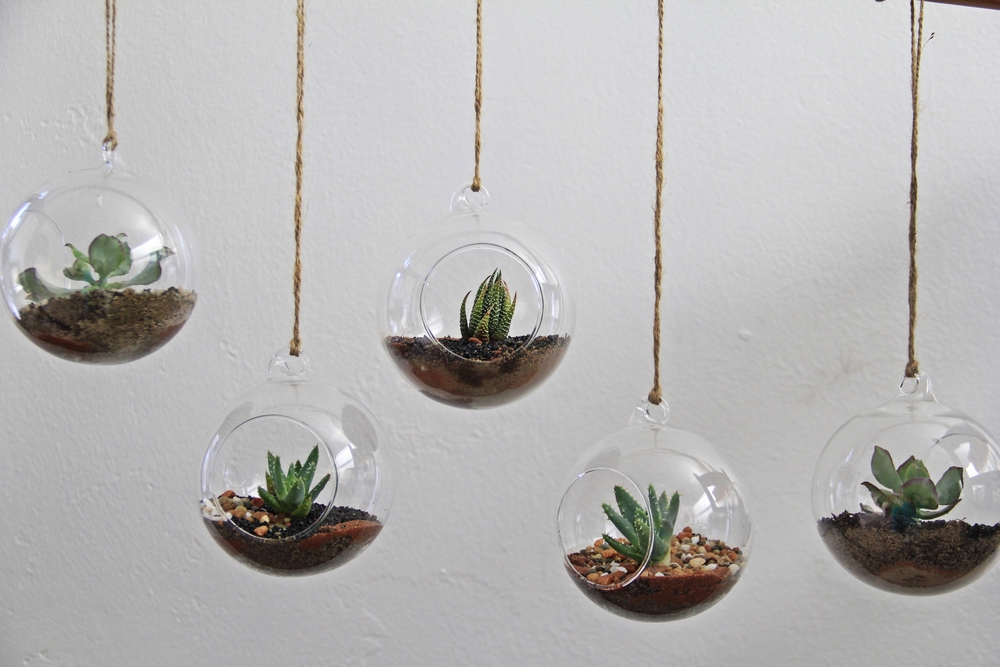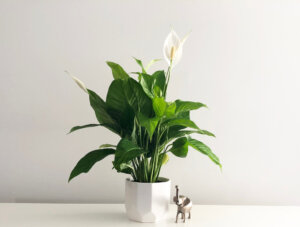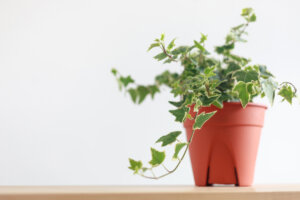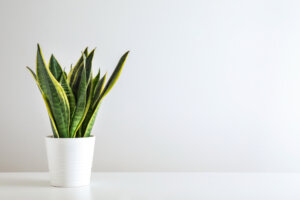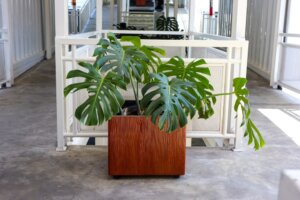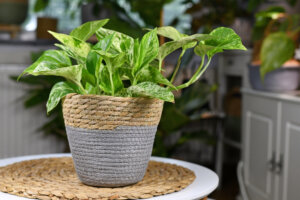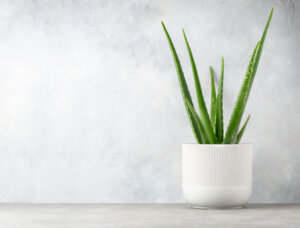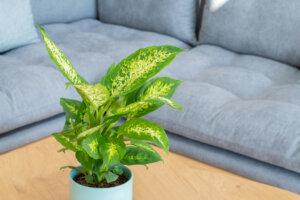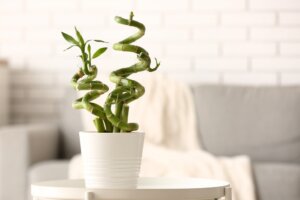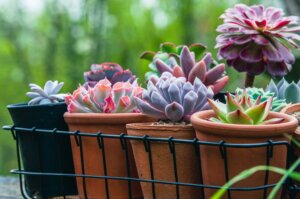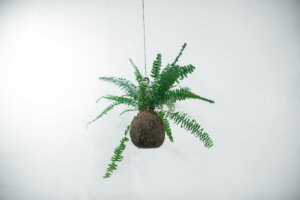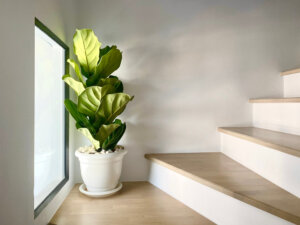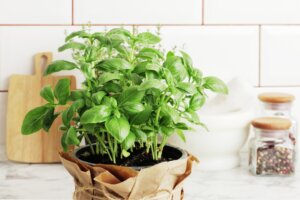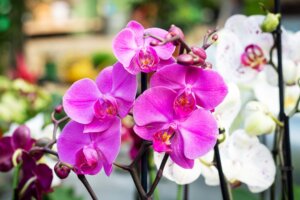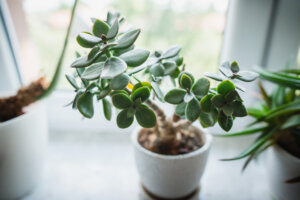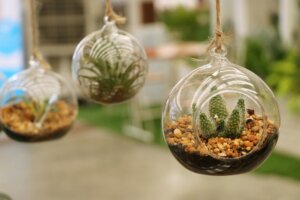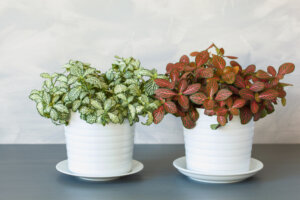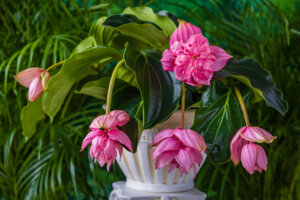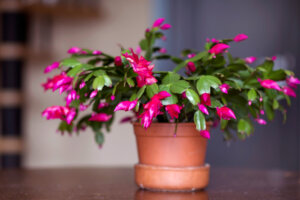Plants are both amazing for your space and your health. They’re the perfect thing to decorate your home with or add in your bathroom. However, they do need regular watering, cleaning, and maintenance (especially during the winter months). Is your green thumb failing you when it comes to houseplants? It’s probably the water! Here’s a master list of how often you should water the most common houseplants to get you started.
Peace Lily
Water: Once a week
As its name suggests, this plant is low maintenance, pretty and actually contributes to your general well-being because of its air-purifying qualities. The key to having this plant bloom its stunning white flowers? Don’t overwater. Check in every week to see if the top of the soil is dry- if it’s still damp, no need to water. Washing the plant under the shower or wiping down the leaves once a year also helps it to process sunlight better.
English Ivy
Water: Mist daily
An elegant plant commonly found in Canadian households, the English Ivy needs bright light to thrive. Keep it in a partly shaded area where it can get enough light (but not too much direct sunlight) – without light, these plants tend to attract pests like whiteflies and mealybugs. Mist it daily to clean the leaves but don’t overwater – ivies prefer slightly dry soil and need to have a good drainage system since they wilt in excess water or overly wet soil.
Snake Plant
Water: Once every 3 weeks
Touted to be one of the best houseplants ever thanks to them surviving long periods of water starvation (especially when you are away on vacation) and for their beautiful, artistic leaves, the snake plant needs minimal light to grow. They thrive in indirect sunlight and need to be watered only when the soil dries up. When watering, avoid wetting the leaves. Also, they rot easily so plant them in free draining soil (high on sand with less clay). Fun fact: It’s also called the “mother-in-law’s tongue”.
Philodendron
Water: Roughly once a week
The moment you see the leaves of a philodendron turning yellow, you know that you have been overwatering (notice a trend here?). Newly potted plants need careful watering in the early days so that the roots don’t dry off, but keep in mind that the soil shouldn’t get soggy. Mist the leaves two to three times a day and you should be good to go. They tolerate low light but not very dim or the leaves tend to be smaller than usual and too much direct sunlight will simply burn the foliage off. Keep away from kids as they may spark off harmful reactions if eaten and irritate the skin and eyes.
Golden Pothos
Water: roughly once a week
When you get a Golden Pothos, also called the Devil’s ivy, remember to water around the container in which it is planted. Again, don’t overwater but keep the soil hydrated. They grow well when watered liberally during the growing season- in winters, remember to add just a moderate amount of water. The pothos usually takes pride of place in the bathroom since they are good with low lighting and because they filter out the toxins hanging about in the air. Also, the moist conditions of a bathroom serve a pothos perfectly!
Aloe
Water: Once a week
One of the simplest plants to look after (especially if you do not have a green thumb), aloe needs to be watered deeply but be careful to let the soil dry at least 2 inches deep between waterings. It does not need much water in the winter. Also, make sure that they are protected from frost in the winter, so keep them warm and cozy — indirect light is best for aloe. Look out for thin and curled leaves; if you see them, your plant is not getting enough water and is probably using up its own liquid.
Dumb Cane
Water: Once a week
Dumb Cane (Dieffenbachia for the purists) thrives in well-draining soil (that is consistently moist) and needs to be watered lightly. Check the soil to make sure it is dry an inch down before watering the plant. It does well with filtered light so keep it by a window with a thin curtain- you don’t want the tender leaves to wilt in strong sunlight. Be sure to rotate this plant regularly so all the leaves get equal amounts of light. A word of caution: the plant is covered with tiny needle-shaped calcium oxalate crystals and if perchance end up in your (or your pet’s mouth) can cause massive swelling, consequently making them unable to speak. Where do you think the name came from!
Trellis Lucky Bamboo
Water: A bit every week with distilled water
This beauty needs some special care- you need to use chlorine and fluoride free water (use distilled water) which needs to be changed completely every few weeks. Make sure the roots are completely covered with water and that the levels are constant. Also, mist the leaves of the lucky bamboo every couple of days if lack of humidity is a problem.
Echeveria
Water: Once a week
This one doesn’t like to be too wet or too dry. Water the soil (not the leaves) because it rots easily, and keep pouring water until it drains out and repeat a couple of times. Keep the mix lightly moist spring through fall and water sparingly in winter. In the winters, make sure to place your plants near the brightest window in your house. Cut back on water and keep the room temperature mild — a cool, sunny room is ideal.
Staghorn Fern Kokedama
Water: Once every 1-3 weeks, depending on the season
This fern needs to be watered once per week in dry, hot summers, and once every two to three weeks as it gets colder. A two-step process of misting and soaking is most effective for this fern. The undersides of the plant should be misted and, subsequently, placed side-down in a sink full of regular temperature water. Soak the plant for 10-20 minutes, or until the root-ball is saturated.
Fiddle Leaf Fig
Water: Once a week
A social media superstar (it features in almost every major home decor Insta page), this ornamental plant looks majestic in a living room corner. Water your fig tree when only the top inch of soil is dry. Give it consistent bright light, preferably by a sunny window. Turn the plant every few months once it begins to lean toward the light.
Basil
Water: Once a week
This herb is a thirsty one, so the container housing it must have drainage holes because whenever you water your basil, you will water until it runs out the bottom. Do not water over the plant and do it in the morning so that it doesn’t evaporate instantly. Be sure to check the soil moisture on a daily basis. Top tip- use plastic and metal containers as they tend to retain moisture longer than terracotta, clay or wood. Margherita pizza for dinner tonight!
Moth Orchid
Water: Once a week
Onto some gorgeous flowering plants now. Water this moth orchid once a week at most but keep the roots and leaves dry by using a pot with proper drainage. In terms of light, keep it near a moderately bright windowsill. Keep it warm at no lower than 17°C. Top tip- orchids remain in bloom for a large part of the year so don’t miss out on repotting this plant.
Lavender
Water: Once a week
This pretty flowering plant is a centerpiece favourite. You can grow lavender fairly easily inside. Simply place the plant in a sunny windowsill and water it regularly allowing the top inch or so of soil to dry out. Remember to rotate the pot every few days to allow sunlight to reach all of the leaves so that it grows uniformly. French lavender is a popular choice because of its lovely, wispy mauve-coloured flowers. And oh the fragrance!
Jade
Water: Once a week
Who doesn’t want a cutesy plant that also brings luck (it apparently brings you loads of cash)! But to keep it alive, it needs more than just that (as in just the right amount of water). Don’t let it dry out completely and don’t water it too much either, which can cause root rot. Water your jade only when the top of the soil in your pot is dry to the touch. Signs that your plant is parched? Your plant is losing leaves or the leaves develop spots. This one needs full sunlight.
Hanging terrariums
Water: Every 4 days
Because their roots are so small, hanging terrariums or air plants take in moisture and nutrients through their leaves. Feed them with a foliar spray fertilizer specially made for air plants. Thoroughly water the soil, then wait for the soil to completely dry out before watering again. Using a low-flow watering spout and other tools help in getting the soil moist in a uniform manner. These plants will thrive only if there is enough light. Hang your little terrariums near a window, but away from direct sunlight and watch as your room comes alive!
Fittonia
Water: Every 5 days
A visual treat, the fittonia has delicate veins (it’s also called the nerve plant) in silvery white, green and pink, and makes for a perfect bottle garden component. They are slightly high-maintenance, needing constant humid conditions and quickly burn under strong sunlight. They need to be watered moderately with room temperature water to avoid shocking it into wilting.
Medinilla
Water: Every 7-10 days
The medinilla, also known as the Philippine orchid can stand being a bit dry but not too wet. Water this plant once every 10 days but remember to drain out all water from the bottom of the pot. For this you need to water it from the bottom- soaking it in a plant dish or a sink. The medinilla is a light lover so from November to March, direct sunlight suits it just fine. After that, it needs more indirect sunlight. It loves being sprayed with mist to combat dryness caused by air conditioners. Watch out for gorgeous pink flowers and tiny berry-like fruit!
Amaryllis
Water: Once a week
Another stunning flower (they come in pink, red and white) that’s super easy to grow and blooms last for as long as six weeks! The amaryllis needs to be kept in cool climates when in bloom and needs more warmth when in stages of active growth. When growing, it needs bright light and moist soil, so go easy on the water. The bulb needs to go sleep for a while, so withhold the water and place it in a dry, cool spot in the house. Once growing season comes around, start your watering schedule.
Christmas Cactus
Water: Every 4-5 days
And to round off, the perfect holiday gift (it’s never too early to plan) for a special family member- the glorious Christmas Cactus. An unassuming potted plant, it sprouts vibrant pink, red, white and even purple and orange around December. A tradition in many North American homes because of its obvious timeliness, the cactus grows best in bright light with moderately dry soil. Water only when the soil is completely dry and make sure it gets some humidity. So start planning now during the fall months- place the cactus in a spot where it receives (indoor) indirect bright light during the daylight hours but complete darkness at night. You will be ready to gift come Christmas Eve!
Inspired? Test out your green thumb with some more tips on how to get a perfect herb garden going in your kitchen!
Article Updated June 2022
